Pandora’s Box 
Here’s a odd thing: back in 1996, Microsoft hired Alexey Pajitnov, the creator of Tetris, to design puzzle games for Windows 95. Pandora’s Box was one of the games Pajitnov worked on with Microsoft, and it marks a surprising step away from the Tetris-style games that had characterized his work up to this point. Instead, it’s a visual puzzle game, defined by an almost archaic sense of wonder.
Pandora’s box, the mythical container of evil from Greek mythology, is reimagined here as a puzzle box, holding the spirits of trickster deities from various myths and folklore, like the spider god Anansi and Puck the fairy. The box has been opened, inevitably, freeing the tricksters so they may wreck havoc once again. As they scramble up the world, you embark on a globe-trotting adventure to re-capture them by cleaning up their disarray, literally putting things back in order.
This is explicitly a game about restoring order from chaos, which, come to think of it, may be the idea motivating the entire puzzle game genre.
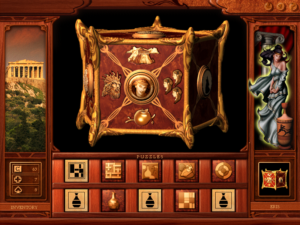
Eris, the Greek god of discord, is certainly having more fun now that she’s free from that old puzzle box
Pajitnov has worked on a number of odd titles over the years, including an aquarium simulator, but by and large, his career has been defined by abstract, endless puzzle games, like Tetris or Hexic. (Or Hatris, his bizarre follow-up to Tetris in which you stack hats.) By comparison, Pandora’s Box is a major departure in theme and format.
For one thing, it has an overarching structure. You’re not just solving puzzles for their own sake; you’re also searching for the missing pieces of Pandora’s box, which have been stolen and scattered around the world. There’s one in each city, hidden behind one of ten random puzzles, and as you find more of them, you can seal the tricksters back into the box. You also collect items, which can help you solve difficult levels or skip them altogether. This framing gives the individual puzzles a purpose, and it keeps you moving between them, never getting stuck too for long and always working towards a bigger external goal.
If you really wanted to, you could skip all this by playing just the puzzles by themselves in a separate “Puzzles Only” mode, but you’d be missing out on a significant part of the game. It’s meant to be a structured experience. Pandora’s Box is a treasure hunt, almost like searching for clues in Carmen Sandiego.
The game has a terrific time with the globe-trotting treasure hunt motif. From the soundtrack up, it channels an early-20th-century spirit of exploration, a bit naive (look, a foreign country!) but also churning with industry and a gusto for adventure. When you go to a new city – accompanied by an Indiana Jones-style flight path on the map – the game treats it with the same kind of wide-eyed tourism as a big-budget movie that’s filming in another country, presenting you with a scenic photo of the city and puzzles drawn from its history, art, and culture. (This is a celebration of art from around the world, and although done respectfully, at times it can feel like it’s just stealing artwork from another culture to make a cool puzzle.) This is played against the puzzle box aesthetic of the game, where the interface is made from intricately carved, polished wood that seems hundreds of years old.
Although Pandora’s Box isn’t an educational game, it feels like a successor to Microsoft’s MindMaze, the trivia game included with the Encarta ’95 encyclopedia, in the way it couches its thinking puzzles in antique pageantry.
The puzzles themselves are all visual, and as soon as you start the first one, it’s clear why Microsoft developed this game. It’s effectively a showcase for the capabilities of Windows 95. The pictures in Pandora’s Box get stretched, rotated, distorted, split up, put back together, and spun around in 3D, which wouldn’t have been possible a few years earlier. Windows 3.1, the previous version of the operating system, would struggle with detailed, moving graphics. But using the DirectX video libraries in Windows 95, you could pull off all sorts of visuals that couldn’t have been attempted in the previous generation. That’s not to say this game is a tech demo – it was released well into the lifespan of Windows 95, after the novelty would have faded – but it certainly feels like an attempt to design a game around what the developers could do now.
(Pajitnov said as much in a press release for Pandora’s Box, stating that the game “take[s] advantage of computer technology by challenging players’ visual skills.”)
There’s ten types of puzzles in Pandora’s Box, each with a different angle on the concept of a visual puzzle. Several of them are in the vein of jigsaws or sliding block puzzles, but they transform the puzzle in some eye-catching manner. The best might be Focus Point, where the pieces can grow and shrink in size. Outer Layer, a puzzle that has you lay textures onto a 3D object, seems especially designed with showing off DirectX in mind. They’re not all winners: Lens Bender tries some gimmick involving magnifying glasses that warp and rotate puzzle pieces, but it never pulls together.
Even when they’re uneven, the puzzles are surprising, often thought-provoking, occasionally delightful, each clever in a different way, and the game benefits from their restless variety. There are so many different forms that chaos can take and ways to restore order from it.
As you capture the tricksters, the difficulty level gradually rises until it reaches a point of saturation. The images get denser and busier, the pieces smaller and less distinctive, until they begin to lose definition, like a jigsaw puzzle so difficult to solve that you have to brute force the solution by matching every piece against every other piece. Eventually, it’s just guesswork. A few of the late-game puzzles have multiple layers, meaning you have to solve a mixed-up puzzle that contains the image of second mixed-up puzzle, up to three layers deep in the final challenge. These barely resemble any identifiable picture; there’s no sensible way to complete them without skipping them entirely. Even the most clever picture puzzles have a threshold where they can’t get any harder without being illegible, and the game knowingly crosses that line several times toward the end.
That’s why the game lets you skip puzzles. There are over 350 puzzles in Pandora’s Box, and you aren’t meant to solve every single one. By the time I finished the game, I had only done about 110. You’re expected to strategically pick which puzzles you’ll actually complete. It’s not a full-blown metagame with a plethora of stats and items to juggle outside the puzzles themselves, but there are shades of that structure, foreshadowing the sort of free-to-play mobile game where the actual content matters less than managing the systems surrounding it.
Pandora’s Box is ecstatic with all these possibilities for what it could be. Imagine a visual puzzle game that uses all the tools of this new operating system! Imagine that Alexey Pajitnov, who’s spent his career making puzzles confined to a small playing field, could design a game that’s a globe-spanning adventure! And what if it wasn’t actually about the puzzles at all?

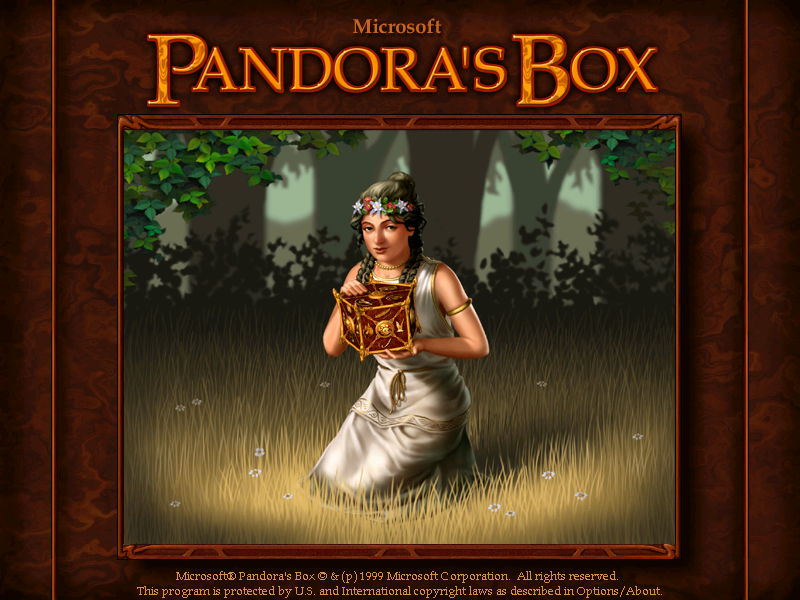
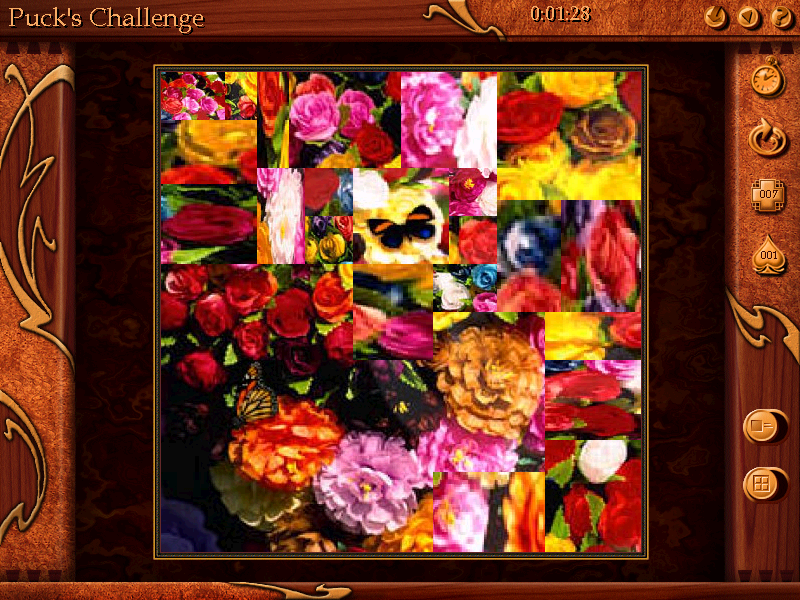
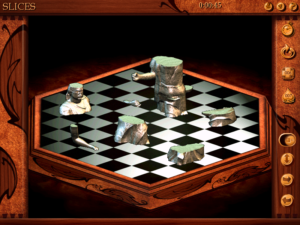
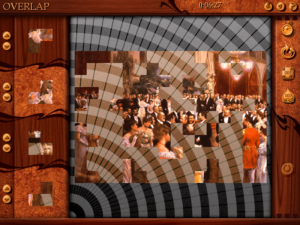
Hooo boy. Used to play this until my eyes hurt back in the day. My whole family did, in fact – even my dad, whose gaming habits never went further than solitaire. I introduced my wife to it at some point, too, and I’m pretty sure she solved all 350+ puzzles.
I’ve been itching to replay it for a while now, and your write-up might just be the thing that pushes me over the edge.
This is one game I still reinstall and replay occasionally.
AndyHat how do hou make or work again in windows10? I havent player it for years because it didn’t work anymore. Still hoping for a similar game.
Right click – Properties – Compatibility tab – select windows 98 from the drop down menu and apply the changes.
The app should now play successfully on Windows 10 ☺️
Bought a new laptop, P/B will not load, so disappointing as it was my relaxation. Please fix my problem!!!
Is there a smartphone version of Pandoras Box Microsoft?
Hi Paula! I don’t believe Pandora’s Box was ever re-released after this version, but it seems like it’d be a good fit!
rae: Unfortunately I don’t think Pandora’s Box works natively in newer versions of Windows. I haven’t experimented, but it may work in either Windows 95 or 98 compatibility mode. The only sure-fire solution is to emulate the old Windows operating systems, which is complicated and may be more than you’re looking for. If you’re still interested and reading this, I can point you towards resources for doing this.
I wish we could somehow get Microsoft to re release this game. It has always been my favorite.
I wish they would re-release this game for current windows or as an app. I would so pay a good amount for this game. This is one of my faves that I have not been able to play in years. Someone should perhaps start a petition type thing and bring it to Microsoft’s attention. There are so many ppl out there that want this game playable.
Agree, would love to see a re-release of this game
I would love to have this game. So challenging!
It should be possible to find versions of the game on abandonware sites that run fine on recent systems. I have one that runs on Windows 10 no problem… but I downloaded it from Abandonware France and you can only play in French (I just reinstalled it to check).
That being said, the game would really benefit from an HD re-release. With an actual encyclopedia of the works/sites featured, and maybe even a puzzle editor ?
Also, fun fact: composer Nathan Grigg later switched to much more action-packed games, his most recent project being Mortal Kombat 1 of all things.
Would buy this game in .2 seconds if it became an app on an iPad or android. This game is iconic.
Beste,
Is diit spel nog te koop?